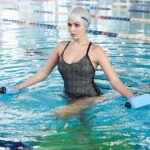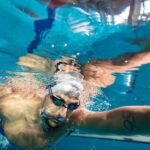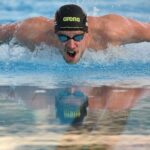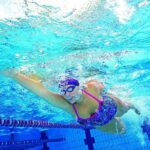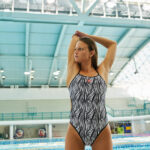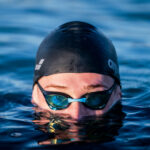Rock-hard glutes thanks to swimming
Plenty of scientific research has confirmed that the top 5 “first things you look at in a woman or a man” include…. their butt!
The glutes are actually a group of three muscles (gluteus maximus, gluteus medius, gluteus minimus) that keep your back straight so that your body remains upright.
The gluteus maximus is the most powerful muscle in the human body, as well as the biggest and strongest.
So, what can you do to strengthen and tone them?
Swimming, aqua fit classes and bodyweight exercises
There are various ways to improve your buttocks and swimming is certainly one of them.
As well as being the best-known and most popular swim stroke, the freestyle’s smooth leg kick allows you to work on your glutes constantly to strengthen and tone them up.
Using your arms ensures you have a balanced workout divided up evenly between your upper and lower body.
On the other hand, the circular movements of the breaststroke allow you to focus on developing your gluteus medius (i.e. the muscle in the top-outside part of your bottom), but be careful: this can be hard on your knees and back if you are not careful.
If you want to really “destroy” your B side, you can swim 1000 m (i.e. 40 laps) of a 25-meter pool with the help of a board.
If you decide to try this out, I would advise you to: alternate freestyle legs with the breaststroke legs, rest your forearms on the board and occasionally dip your head underwater drawing your chin in towards your neck so that you do not over-strain your neck (C1-C8).
Aquafit classes may be ideal for you, if you do not like swimming or if you need to be assisted.
Since this is a “vertical” work-out, generally done up to your waist in the water, it is an easy way to tone your muscles in complete safety.
If, on the other hand, you want to work out on your own, you can focus on bodyweight exercises.
My advice is to devise a training plan with the right number of repetitions and rest between sets.
Here are two suggestions:
1. Exercise in the big pool.
Kickbacks with straight legs
With your chest or stomach resting on the edge of the pool, alternate kicking your legs backward with your knees straight and your feet facing forwards.
To make this exercise harder, you can attach an elastic band to your ankles.
I suggest 3 sets of 15 reps with 30 sec. – 45 sec. rest between sets.
2. Exercise in the small pool.
Squats in the water
Standing in the small pool with your heels wider apart than your shoulders, point your feet outwards at an angle of approximately 30°.
Push your hips slightly backward and gently bend your legs as you slowly lower your body downwards.
Stop when your thighs are parallel to the bottom of the pool.
Keep your back straight and do not lift your heels off the floor.
Slowly return to your starting position and perform three sets of 10 reps with 45 sec. rest between sets.
These exercises can also be performed out of your “beloved” pool, but remember that water resistance makes you work harder and will have a much better effect on your backside!
It is now time for a well-deserved shower and a bit of relaxation so that you are ready for our next article!
—————-
Reading list:
Anatomia umana; scienze motorie preventiva ed adattata; Pavia University.
Fisiologia umana; scienze motorie preventiva ed adattata; Pavia University.
Written by:
Marco Borreca
Marco Borreca was born in Milan in 1985. After his competitive swimming career, he continued his sports studies graduating from the faculty of Preventive and Adaptive Motor Sciences in Pavia. He has been working as a swimming/ fitness instructor and rehabilitation expert at various sports centres since he was very young. He mainly focuses on using water for recovering motor skills in the case of sports injuries and disabilities. He currently works for a municipal sports centre as the Head of Fitness and also works for a private practice as a kinesiologist.
